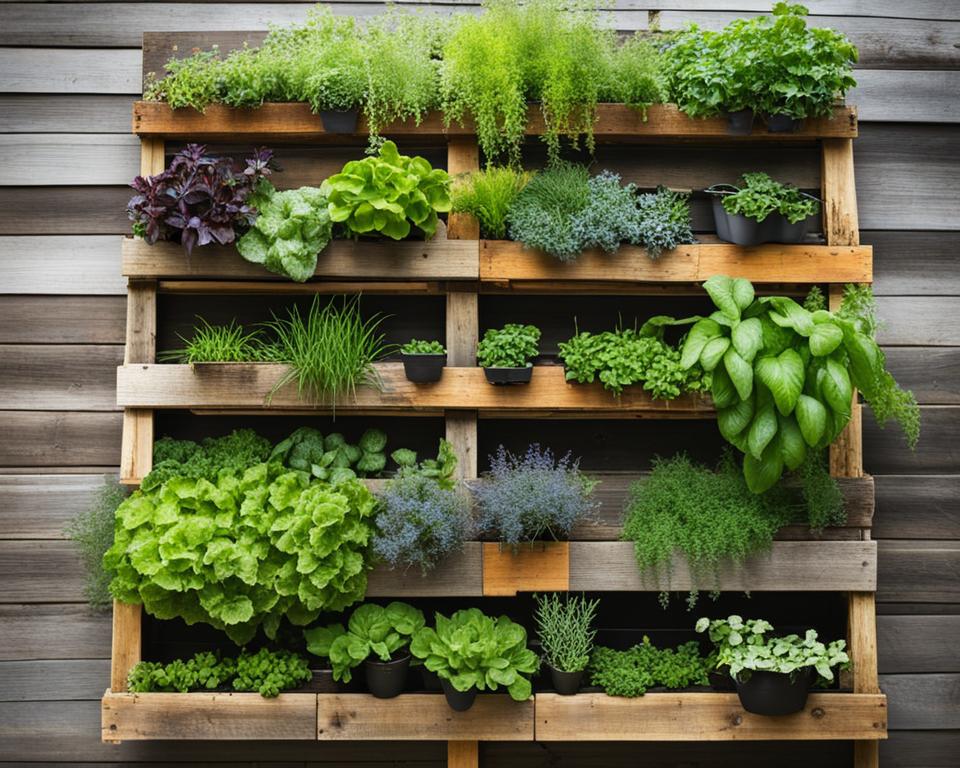Imagine transforming your compact backyard into a thriving oasis teeming with fresh produce and flourishing plants. With the innovative approach of vertical gardening, you can maximize your garden’s potential, even in the smallest of spaces. Learning how to do vertical gardening is not just about saving space; it’s a creative journey towards vastly improved yields, simpler maintenance, and robust disease prevention.
Vertical gardening techniques
allow you to scale your greenery skywards, utilizing structures like garden arches and pallet gardens to foster upward growth. Embrace the ease of harvesting and the pain relief of this back-saving gardening trend. Discover living walls that add dimension to your garden and understand the critical practice of responsible watering, which is especially crucial in vertical setups.
Whether it’s a DIY vertical gardening project you’re embarking on or just seeking the best plants for vertical gardening, this guide will equip you with the necessary know-how. Get ready to cultivate an awe-inspiring vertical garden that stands tall and proud, providing you with not just food and flowers, but also a delightful slice of nature’s serenity.
Key Takeaways
- Understand and apply various vertical gardening techniques to optimize limited outdoor spaces.
- Identify the best plants suited for vertical gardening and cater to their specific needs.
- Explore creative vertical garden ideas that enhance both functionality and aesthetic appeal.
- Learn efficient DIY vertical gardening projects that are simple and cost-effective.
- Appreciate the benefits of vertical gardening for easier maintenance and disease prevention.
Understanding the Basics of Vertical Gardening
When space is at a premium, vertical gardening for small spaces unlocks a new dimension of greenery in your home. It’s a technique tailored to urban environments where horizontal space can be scarce. By turning your gaze upward and making the most of vertical surfaces, you can transform a compact area into a lush garden. This approach centers on the use of vertical gardening systems such as wall planters, hanging baskets, and freestanding trellises.
One of the significant benefits of vertical gardening is the physical ease it brings to gardeners. Those who struggle with the bending and kneeling associated with traditional gardening will appreciate the ergonomic advantages. Enhanced air circulation, vital for plant health, is a given with vertical installations, and when you increase sunlight exposure, your plants aren’t just surviving; they’re thriving.
However, it’s important to navigate the challenges peculiar to vertical gardens. Expect a need for more attentive watering practices, as the elevation can lead to a quicker drying of soil.
| Aspect | Benefits | Considerations |
|---|---|---|
| Space Utilization | Expand growing area vertically, ideal for balconies, patios, or tiny yards. | Requires sturdy support, adjustment to garden layout. |
| Plant Health | Better air flow reduces disease; increased sunlight enhances photosynthesis. | Plants at the top might cast a shadow; care in positioning is key. |
| Ergonomics | No need to bend over; easier to maintain and harvest. | Setup may require an initial investment in structures and systems. |
| Watering | Gravity aids in water distribution in certain systems. | Top plants may create a rain shadow effect, making lower plants drier. |
As you embrace vertical gardening, consider your personal preferences and the unique specifications of your living space. The right system can offer not only an aesthetically pleasing environment but also a fruitful harvest, year-round.
Maximizing Your Space with Vertical Garden Structures
When you’re exploring how to do vertical gardening, choosing the perfect structures becomes essential to support the diverse range of plants and maximize your available space. Structures not only provide support but can also be a statement in your garden, reflecting your personal style and aesthetic preferences. With an array of vertical gardening techniques, you can turn a bland wall or fence into a lush and productive garden area.
Choosing the Right Structures for Your Garden
Every plant has unique requirements, and matching those needs with the right supporting structure is crucial for a thriving vertical garden. Whether it’s the delicate tendrils of climbing peas or the robust vines of a squash plant, the support system you choose needs to be both functional and suited to the weight and growth pattern of your plants. Some popular support structures include trellises, tripods, and sturdy wire cages. Assessing your plants’ needs and the conditions of your garden will help you select the ideal structure that not only optimizes space but also accentuates your vertical garden ideas.
DIY Trellis and Support Ideas
For garden enthusiasts who love DIY projects, creating your own trellis and supports can be a rewarding and cost-effective way to dive into vertical gardening. Recycled materials like old wooden ladders, pallets, or even repurposed furniture can be turned into functional pieces. Affordable options such as netting stretched over a frame or strings tied between secure posts can offer accessible solutions for plants in need of a guiding hand as they grow upwards.
Incorporating Arches and Pergolas
Arches and pergolas not only serve as support for climbing plants but also add architectural interest to your garden. Whether draped with flowering vines for a romantic touch or covered with fruiting plants for a practical use of space, these structures are as beautiful as they are functional. When dealing with heavier plants like grapevines or certain types of squash, ensure that your arches and pergolas are constructed with durability in mind to withstand the weight.
Integrating vertical gardening structures involves both creativity and practicality. The table below outlines a comparison of different structure types and their suitable plant pairings, helping you make an informed decision for your own vertical garden.
| Structure Type | Material | Best Used For |
|---|---|---|
| Trellis | Wood, Metal, Bamboo | Climbing peas, Morning glories |
| Arch | Metal, Wood | Roses, Grapevines |
| Wire Cage | Welded Wire, Metal Mesh | Tomatoes, Bell peppers |
| Pergola | Wood, Vinyl | Wisteria, Kiwi fruit |
| Bamboo Pole | Bamboo | Bean varieties, Sweet peas |
| Cattle Panel | Galvanized Steel | Squash, Cucumbers |
How to Do Vertical Gardening: Key Techniques and Approaches
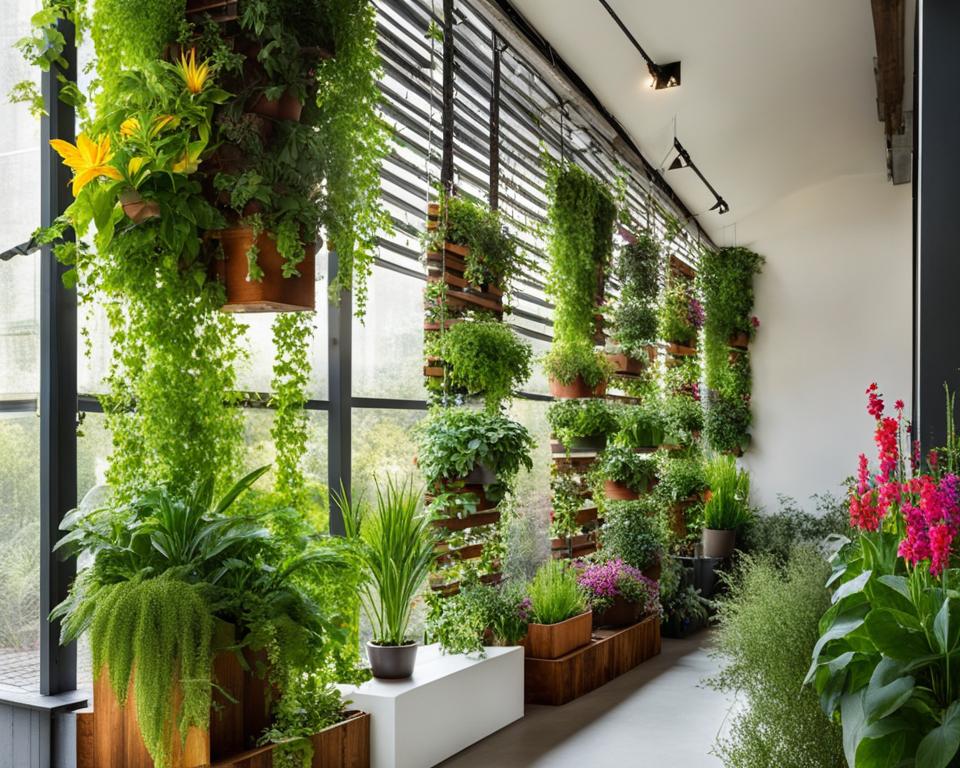
Vertical gardening is not only a space-saver but also a creative endeavor that can transform the look and feel of your home or garden. To get started, DIY vertical gardening strategies can be both fun and functional, allowing you to grow more in less space. Utilizing the vertical plane opens up a myriad of possibilities for plant enthusiasts and urban gardeners alike.
One popular method involves the use of living walls, which can be as simple as attaching planters to a wall or as complex as creating built-in systems with integrated watering. Living walls can house a variety of best plants for vertical gardening such as herbs, ferns, and succulents, depending on the amount of light and exposure they receive.
Another vertical gardening approach is constructing bean teepees, which are not only practical but also add a visually interesting element to your garden. These teepees can support a variety of climbing plants, from sweet peas to runner beans, and are relatively easy to build using bamboo sticks or branches. By growing upwards, you maximize your yield and make harvesting a breeze.
For those who enjoy upcycling, pallet planters are an intriguing project. With some basic modifications, old pallets can become vertical gardens suitable for small spaces and balconies. They are perfect for cultivating strawberries, herbs, and lettuce, along with other small plants that don’t require deep root space.
One of the essential vertical gardening tips is to select the right soil mix. A well-draining, nutrient-rich potting mix will ensure that your vertical garden thrives. Climate considerations are also crucial – make sure to choose plants that can adapt to your region’s weather patterns.
Maintaining hydration is one of the significant challenges in vertical gardening, given that gravity tends to pull water away from the plants at the top. Drip irrigation or a self-watering system can help maintain consistent moisture levels, which is vital for the health of your garden.
You’re now equipped with the fundamental knowledge to embark on your vertical gardening journey. Use these insights to make the most of your vertical space, facilitate a lush, thriving garden, and enjoy the bountiful harvest it will bring.
Selecting the Best Plants for Vertical Greenery
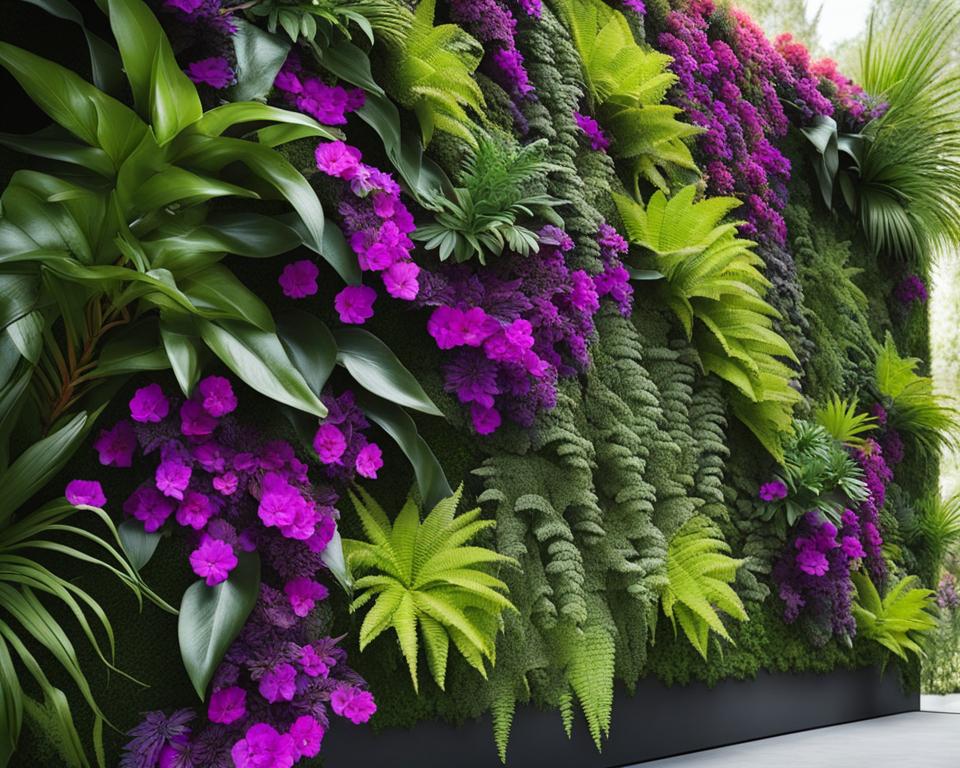
Embracing vertical gardening for small spaces not only maximizes your gardening potential but also introduces a vibrant tapestry of greenery right at your fingertips. Before you begin, understanding which plants are best suited for your vertical oasis is crucial. Find a balance between ornamental charm and edible yield as you select from an array of plants with different sunlight requirements and growth habits. This key step ensures that the practical benefits of vertical gardening align beautifully with aesthetic allure, transforming any petite plot into a towering Eden.
Top Vegetables Suited for Vertical Growth
When you aim to pair the benefits of vertical gardening with culinary delights, some vegetables stand out as stars of vertical spaces. Discover how pole beans and climbing peas vault upward with ease, while sweet potatoes and vining tomatoes spread zest along trellises and walls. For each, their growth nature finds harmonious expression when set against the vertical canvas, yielding abundant harvests that celebrate both form and function.
Decorative and Edible Plants for Aesthetic Appeal
Vertical gardens serve as a junction of utility and splendor, especially when you incorporate decorative and edible plants. Beyond the staples, consider bright nasturtiums and fragrant herbs that offer pops of color and a feast for the senses. They not only attract pollinators but also provide an accessible supply of garnishes and herbal infusions, illustrating the seamless integration of best plants for vertical gardening into your daily life.
Understanding Sunlight and Shade Needs for Vertical Plants
Successful vertical gardening for small spaces depends on matching plant preferences with sunlight exposure. It’s essential to identify which areas of your vertical setup receive full sun and which are more shaded. This knowledge allows you to position your plants strategically, ensuring that each thrives according to its natural inclinations for sunlight or shade, thereby bolstering plant health and productivity.
Benefitting from Vertical Gardening: Why Grow Upwards?
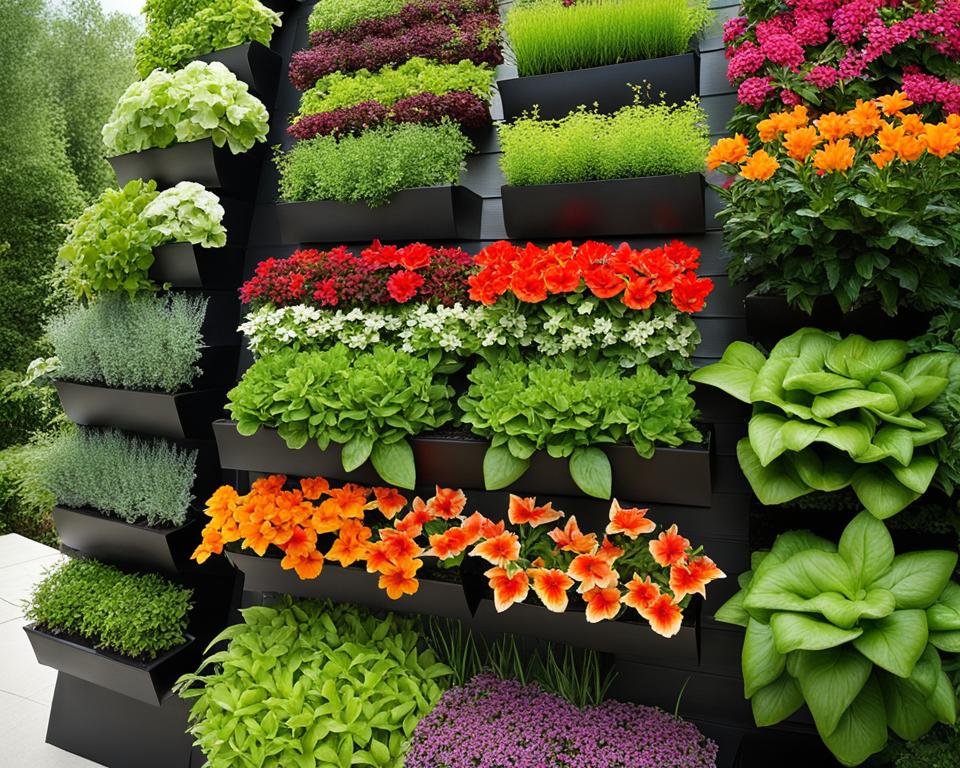
Embracing the upward climb of vertical gardening is more than a trendy choice; it’s a strategic move that offers a multitude of benefits. By integrating vertical gardening techniques into your green space, you’re not just saving on square footage; you’re investing in a gardening practice that will reward you with a richer, more accessible harvest. Let’s delve into how going vertical can elevate your gardening experience, yield advantages, and contribute to healthier plant life.
Enhanced Accessibility and Yield
The beauty of vertical gardening lies in its clever use of space. The practicality of growing upwards means increased yields in a smaller footprint, particularly beneficial for urban gardeners and those with limited outdoor areas. Imagine the pleasure of plucking fresh tomatoes or snipping vibrant herbs right from your balcony or patio, without the strain of bending or kneeling. These are just a few of the benefits of vertical gardening that make every harvest bountiful and effortlessly within reach.
Disease Prevention and Improved Air Circulation
Plants that are suspended off the ground are less prone to soil-borne diseases, and the enhanced air circulation they enjoy is a boon for preventing the spread of pathogens. Vertical gardening techniques not only improve the overall health of your garden but also result in stronger, more vigorous plant growth. You’ll find that managing the well-being of your vertical garden is a breeze when you employ these savvy gardening tips.
Back-Saving Gardening Practices
One of the greatest vertical gardening tips revolves around the ergonomic advantage it provides. By minimizing the need for constant bending and stooping, maintaining a vertical garden is kinder to your back and joints. Whether you’re tending to vibrant flowers or nurturing a crop of vegetables, these vertical gardening techniques ensure a more comfortable and sustainable gardening practice, making it a delight for gardeners of all ages.
Watering Systems for Vertical Gardens: Efficient Irrigation Tips
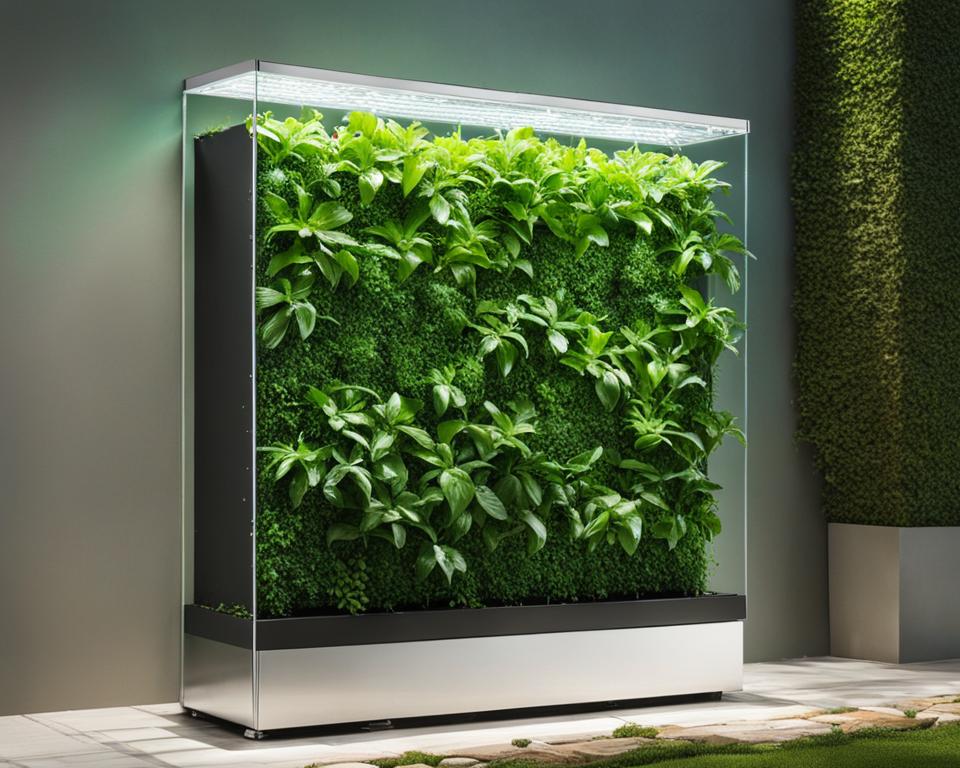
Crafting a lush vertical garden is a delightful and productive way to beautify any space, but handling watering demands is critical. As plants in vertical gardening systems can dry out more rapidly compared to their horizontal counterparts, it is vital to implement efficient watering practices. By employing the right strategies, your green haven can thrive without the fuss of constant manual watering.
Monitoring Moisture Levels in Vertical Setups
Understanding the moisture requirements of your vertical garden is key. Unlike traditional gardens, vertical gardening tips often emphasize the need for regular moisture checks. Using a simple soil moisture gauge can help you assess when your plants need water. This tool enables you to water your plants precisely when needed, preventing both under and overwatering.
Drip Irrigation Solutions for Consistent Water Delivery
Drip irrigation is a highly effective method for DIY vertical gardening. It delivers water directly to the roots of each plant, minimizing water waste and ensuring each plant receives the hydration it needs to flourish. Because water is delivered drop by drop, plants have time to absorb moisture efficiently, and the risk of water evaporation is significantly reduced. This system can be customized to fit various types of vertical gardens, making it a versatile and ecologically sound option.
Setting Up Timers for Optimal Watering Schedules
Using timers can take the guesswork out of your vertical garden’s watering schedule. Timers can be attached to your drip irrigation system, ensuring that your plants are watered at the best times of day to avoid evaporation during the heat of the day or potential chill at night. Smart timers can even adjust watering based on the weather, ensuring your vertical gardening systems are not only efficient but also adaptable to changing environmental conditions.
Eco-Friendly Vertical Gardening: Sustainable Practices
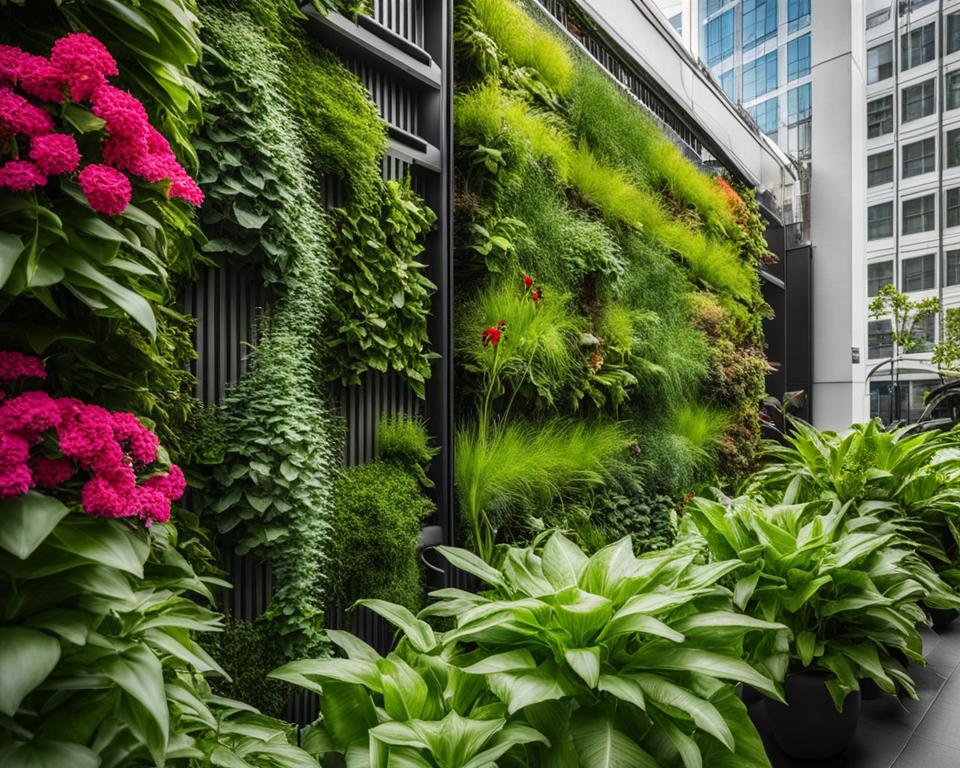
Discover the benefits of vertical gardening by delving into the realm of eco-friendly vertical gardening. Embrace gardening techniques that not only yield a plethora of plants in a confined space but do so with minimal environmental impact. In this section, we’ll explore how to integrate sustainable vertical garden practices into your green space, contributing to a healthier planet and a more abundant harvest.
One of the key advantages of vertical gardening is the ability to use vertical space efficiently, which can lead to significant water savings. Utilizing drip irrigation systems and moisture-rich soil can help retain water and reduce the need to water frequently. Vertical gardens also have the potential to create microclimates that conserve moisture, further diminishing water waste.
Beyond just the conservation of water, eco-friendly vertical gardening involves repurposing and recycling materials that otherwise would contribute to waste. Shipping pallets, old containers, and discarded building materials can all find new life as part of a sustainable vertical garden structure. Not only does this approach reduce waste, but it also adds a unique aesthetic character to your garden space.
Here’s how to construct your sustainable vertical garden:
- Choose a location that receives adequate sunlight and has vertical support.
- Recycle materials to create planters and supports, or use sustainably sourced products.
- Opt for organic soil and compost to encourage healthy plant growth.
- Implement a water-conserving irrigation system such as a drip irrigation.
- Plant native species to support your local ecosystem.
Sustainable gardening not only promotes a vibrant and productive garden but also encourages a more mindful approach to the resources we consume. Through eco-conscious decisions and innovative design, vertical gardens become a testament to the possibilities of sustainable urban living. Engage with your community to share strategies, swap materials, and inspire a greener approach to gardening in your neighborhood.
| Eco-Friendly Practice | Benefits |
|---|---|
| Water Conservation | Reduces utility costs and preserves precious water resources. |
| Repurposing Materials | Minimizes waste and turns potential trash into functional art. |
| Organic Soil Use | Supports plant health and avoids chemical fertilizer runoff. |
| Native Planting | Enhances local biodiversity and provides habitats for pollinators. |
| Community Engagement | Strengthens social ties and spreads eco-awareness. |
In conclusion, eco-friendly vertical gardening is more than a trend; it’s a movement toward sustainable living. By adopting these practices, you contribute to a cycle of life that supports not only your own well-being but also that of the larger environment. Embark on your sustainable gardening journey and witness its transformative power.
Building and Caring for Climbing Vegetable Gardens
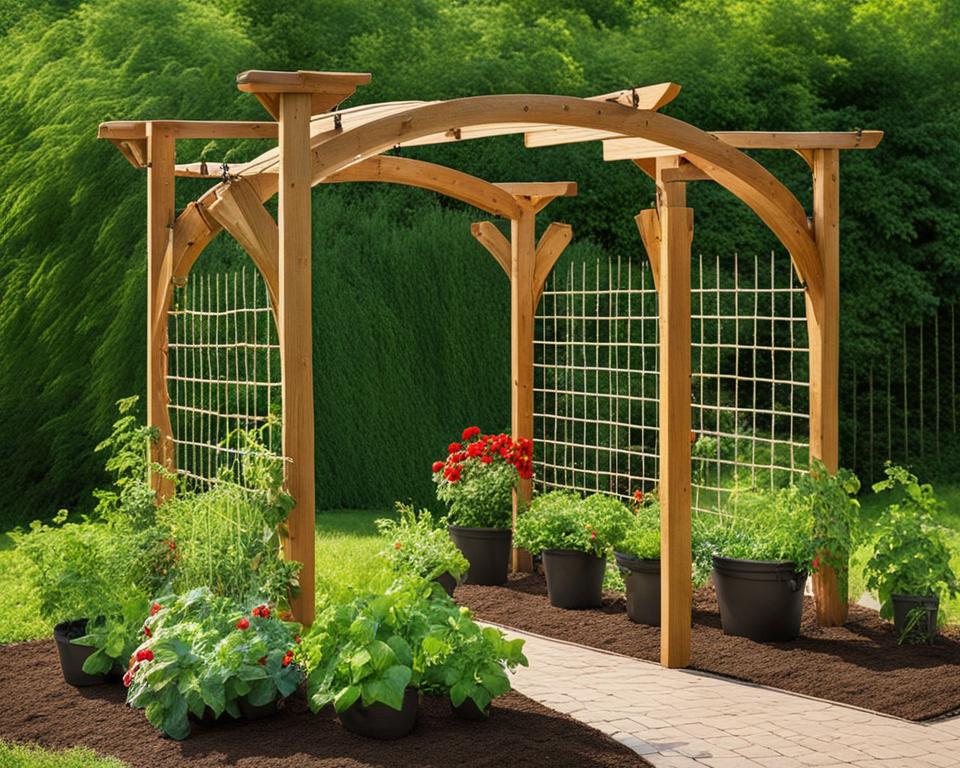
Embark on a journey to elevate your garden space with the innovative and visually appealing world of vertical gardening. Ideal for those seeking to create an oasis in urban settings or to make the most of their limited outdoor space, DIY vertical gardening is not just about plant placement; it’s about crafting an environment that thrives upward, expanding your green thumb to new heights.
Crafting Garden Arches for Beans and Vines
Climbing vegetables, such as beans, cucumbers, and vining tomatoes, are perfectly suited for vertical gardening tips that emphasize upward growth. By building sturdy and aesthetically pleasing garden arches, you provide these plants with the support they need to grow healthily and abundantly, while simultaneously creating a garden feature that captures the eye.
Constructing your own arches can be a fulfilling weekend project. Use materials like bent metal rods, wooden laths, or PVC pipes to form the frame, and then add a net or wire mesh to support the climbing plants as they grow. Not only do these structures save space, but they also allow for easier picking when harvest time arrives. And don’t forget, the proper vertical care includes regular pruning and guiding tendrils onto the structures.
Creating Living Walls for Dynamic Garden Backdrops
Living walls aren’t just for the avant-garde gardener—they’re a practical solution packed with benefits. These dynamic backdrops bring life to bare spaces and concrete patios, turning them into lush canvases that purify air and delight the senses. Choose from a variety of best plants for vertical gardening, like ferns, succulents, and herbs to design a living wall that fits your aesthetic and culinary needs.
Begin with a frame that can hold pots or planters, ensuring there’s adequate space for root growth. Consider the amount of sunlight and water each plant will need, as these factors dramatically influence your living wall’s success. With the right setup, a living wall keeps your garden green year-round and can even act as a natural insulator for your home.
Supports for Vertical Growth: Beyond Functional to Decorative
The beauty of vertical gardening lies in its fusion of form and function. While trellises and plant stakes are standard solutions, you can think beyond these conventional options. Decorative supports, such as intricate latticework, antique gates, or sculptural elements, can become the centerpiece of your garden while serving their primary purpose.
| Support Type | Best Plants | Functional Benefit | Decorative Appeal |
|---|---|---|---|
| Trellis | Climbing roses, morning glories | Maximizes vertical space, promotes air circulation | Can range from simple lattice patterns to elaborate designs |
| Tepee | Pole beans, sweet peas | Simple to build, ideal for rotational planting | Rustic charm, adds vertical interest |
| Wire Cages | Tall tomatoes, bell peppers | Keeps fruit off the ground, reduces disease | Metallic structure blends with foliage, provides industrial look |
| Obelisks | Clematis, honeysuckle | Sturdy support for heavy climbers | Architectural silhouette, focal point in garden design |
Remember, the secret to DIY vertical gardening is understanding that every plant has unique needs. Choose your supporting structures based on what will best support the overall health and growth patterns of your plants. With a little creativity and these vertical gardening tips, you’ll have a vibrant and productive vertical garden that stands tall and proud.
DIY Vertical Gardening Projects: Simple and Creative Ideas
Unleashing the full potential of vertical spaces in your home and garden can transform even the most cramped corners into lush, productive retreats. With a dash of creativity and a sprinkle of DIY spirit, vertical gardening for small spaces evolves from a mere necessity to a vibrant art form. So, let’s delve into crafting your own green oasis with these ingenious and DIY vertical gardening concepts.
From Pallet Planters to Bean Teepees
Reclaiming used pallets and converting them into space-saving planters is not only eco-friendly but a true statement of sustainability at its best. For climbing vegetables such as beans, constructing teepees out of bamboo sticks or branches can provide an ideal growing structure that’s as visually appealing as it is functional. Embrace these vertical garden ideas, and watch your vines reach towards the sky, yielding an abundance of fresh produce along the way.
Upcycling Materials for Unique Garden Features
Imagine transforming an old ladder into a series of cascading plant shelves or repurposing colorful soda bottles into a stunning hanging garden. Upcycling offers limitless possibilities to introduce personalized touches to your vertical gardening endeavors. These special additions not only serve as conversation starters but also bear witness to your ingenuity and commitment to the environment.
Making Use of Vertical Space in Urban Areas
In the heart of the city, where the ground is scarce, the sky is the limit for garden spaces. Utilize balcony railings to hang planter boxes, or create a focal point on an empty wall with a DIY living tapestry of herbs and flowers. Remember, every inch of vertical area is an opportunity for growth, offering a breath of fresh air amidst the urban jungle.
| DIY Project | Materials Needed | Space Requirement | Best Plants |
|---|---|---|---|
| Pallet Planter | Wooden pallet, landscape fabric, staples, soil | Can vary; fits against walls | Herbs, strawberries, succulents |
| Bean Teepees | Bamboo poles or branches, twine, soil | Small footprint; tall vertical growth | Pole beans, peas, morning glory |
| Ladder Shelves | Old ladder, wood planks, paint (optional) | Lean against wall; scalable height | Decorative pots, potted flowers, small plants |
| Bottle Hanging Garden | Plastic bottles, scissors, rope or wire | Dependent on available hanging space | Small herbs, ivy, philodendron |
Whether you’re an urban dweller looking to add a splash of green to your apartment or a homeowner wanting to maximize your garden’s yield, these DIY vertical gardening ideas present not just solutions but a lifestyle. Take the leap and watch your garden grow—in every sense of the word—bringing new dimensions of joy and utility to your outdoor or indoor space.
Making Harvesting Easier with Vertical Gardening Systems
One of the most gratifying moments for any gardener is the harvesting phase, and vertical gardening systems have turned this stage into an effortless and enjoyable task. Utilizing vertical space not only enhances the growth of your plants but also significantly simplifies the harvesting process. By elevating your crops off the ground, you reduce the need to bend and stoop, thus minimizing strain on your back and knees. This ergonomic advantage is particularly beneficial for gardeners who face mobility challenges.
Vertical gardening systems have revolutionized the way we approach garden design, providing both novice and experienced gardeners with the tools to produce abundant yields in a fraction of the traditional garden footprint. The intuitive nature of vertical gardens presents you with clear visibility of ripe produce, which facilitates quicker and more efficient harvesting, ensuring that no fruit or vegetable goes unnoticed.
Fruits and vegetables climbing up trellises, arbors, and other supports are more accessible and less likely to be damaged during the harvesting process. This arrangement also allows for better air circulation around the produce, reducing moisture accumulation and the likelihood of disease and pests, resulting in cleaner, healthier, and more bountiful harvests.
With vertical gardening, you’re not only maximizing your planting space but also streamlining the task of picking your hard-earned crops. Whether you’ve grown luscious tomatoes, crisp beans, or vibrant peas, here’s a summary of the benefits your vertical gardening system brings to the harvesting table:
- Easier reach for picking produce
- Less physical stress by minimizing bending and stretching
- Increased visibility of ripe fruits and vegetables
- Decreased risk of produce damage during harvest
- Enhanced air flow around produce, reducing disease risk
Implementing a vertical gardening system is not only a productive use of space, it’s a lifestyle change that enriches your gardening experience. Harvest time becomes a moment of pleasure rather than a laborious chore, allowing you to enjoy the fruits of your labor—quite literally—without the added strain. Embrace the vertical gardening revolution and enjoy plentiful harvests season after season.
Cultivating Beauty and Bounty: Aesthetic Aspects of Vertical Gardens
When you consider the aesthetic impact of vertical gardens, it becomes clear that they offer more than just efficient plant growth; they’re a canvas for horticultural artistry. The vibrant colors and textures can transform dull walls into living masterpieces, turning a functional space into a serene oasis. Whether it’s a tapestry of succulents or a cascade of blooming flowers, each vertical garden has the potential to enhance the visual appeal of your environment.
The beauty of a vertical garden lies in its versatility; the only limit is your imagination. To help you visualize the potential, let’s break down the visual elements vertical gardens bring to spaces:
- **Color Harmony:** Designing your garden with a thoughtful color scheme can elevate the mood and create themed backdrops.
- **Texture Richness:** Combining plants with different leaf shapes and sizes adds depth and tactile variety to the display.
- **Structural Dynamics:** By incorporating structures such as trellises or modular panels, you create a three-dimensional growing space that can both captivate and inspire.
But it’s not just about looks. A well-designed vertical garden can also be a boon for local biodiversity, inviting a medley of pollinators right at your window-step. Let’s explore the relationship between plant choices and their ecosystem services:
| Plant Type | Visual Appeal | Biodiversity Boost |
|---|---|---|
| Flowering Perennials | Vibrant colors, year-round interest | Attracts bees, butterflies, and birds |
| Foliage Plants | Varied textures, shades of green | Provides habitat for insects |
| Herbs | Aromatic, culinary appeal | Supports a variety of insects |
| Vines | Natural drapery effect | Offers nesting spots and food |
Beyond biodiversity, consider the therapeutic qualities of such gardens. The soothing greens and the gentle rustle of leaves can be a form of natural stress relief, contributing to mental well-being.
Remember, the integration of vertical gardens into urban areas also serves a practical function, acting as noise buffers and microclimate regulators. It’s not just a feast for the eyes, but a multi-sensory experience that engages touch, smell, and even sound.
Ultimately, the creation of your vertical garden combines both beauty and bounty, offering a stunning display that nurtures both the body and soul. So go ahead, let your garden scale new heights and become a sanctuary where nature meets aesthetic ingenuity.
Conclusion: Advancing Your Gardening with Vertical Techniques
We’ve travelled through an extensive exploration—from the foundational understanding of vertical gardening to innovative ideas for maximizing garden yields and aesthetics. The essence of vertical gardening is a creative, efficient approach to turning small spaces into vibrant, thriving ecosystems. By implementing structures such as trellises, pallets, and living walls, you can not only grow food efficiently but also beautify your environment. Remember: the upward growth system, while trendy and space-saving, also demands careful attention, particularly in watering and plant selection.
As we’ve seen in Sections 1 through 10, the benefits of vertical gardening are manifold. Enhanced accessibility, disease prevention, and a back-saving approach to cultivation are just a few. This leap in gardening techniques also contributes to a healthier environment by encouraging eco-friendly practices, such as sustainable water usage and the repurposing of materials. Whether you’ve constructed a DIY pallet planter, set up drip irrigation, or selected the perfect climbing plants, each step you take is an advancement in your gardening journey.
Whilst Sections 11, 12, and 13 broaden the scope of the article for thoroughness, this conclusion serves to refine your vision of vertical gardening as a profound, practical, and pleasurable pursuit. Practice the discussed techniques, and your vertical garden will not just rise in stature but also in productivity and beauty, sharing the splendor and bounty of nature right outside your door—or on your very wall. Embrace these strategies, and watch as your garden, and perhaps even your approach to life, grow ever upwards.
FAQ
How do I get started with vertical gardening?
Begin by deciding what type of plants you want to grow and research which structures they need for support, such as trellises or wall planters. Then, source or create your vertical structures and select a suitable location that fits your plants’ sunlight and space requirements.
What are the best plants for a vertical garden?
Some of the best plants for vertical gardening include pole beans, climbing peas, vining tomatoes, cucumbers, and certain varieties of flowers like clematis and morning glory. Always consider the specific requirements of each plant in terms of sunlight, water, and climate.
Can vertical gardening save space?
Absolutely. Vertical gardening is ideal for small spaces as it allows you to grow upward, utilizing vertical structures instead of spreading out over large plots of land.
What types of vertical structures can I use in my garden?
You can use a wide range of structures including trellises, vertical pallets, wire cages, garden nets, arches, pergolas, and even repurposed items like old ladders or hanging shoe organizers.
Is vertical gardening more labor-intensive than traditional gardening?
Not necessarily. Vertical gardening can actually make maintenance tasks easier by reducing the need to bend down, making harvesting simpler, and improving air circulation for plants—which can reduce pest problems and disease.
How often should I water my vertical garden?
Vertical gardens often require more frequent watering than traditional gardens because they can dry out faster. It’s essential to monitor the soil moisture regularly and consider a drip irrigation system to provide a steady supply of water without overwatering.
Are there any particular benefits to vertical gardening?
Yes, vertical gardening can increase plant yields by using vertical space, improve accessibility, reduce the likelihood of plant disease by facilitating better air circulation, and create beautiful living walls that add aesthetic value to your space.
Is it possible to make my own vertical gardening structures?
Definitely. Many gardeners enjoy DIY projects like creating trellises from bamboo poles, using wooden pallets for planting, or building bean teepees. These can be cost-effective and customizable to fit your garden’s needs.
What is a living wall and how can I create one?
A living wall is a vertical structure that is entirely covered with plants. To create one, you’ll need a support system that can handle the weight of plants, soil, and water. You’ll then add a mixture of plants chosen for their growth habits and environmental needs.
Can I apply sustainable practices to my vertical garden?
Yes, sustainable practices like using recycled materials for structures, conserving water with efficient irrigation systems, and choosing native plants can all contribute to an eco-friendly vertical garden.

